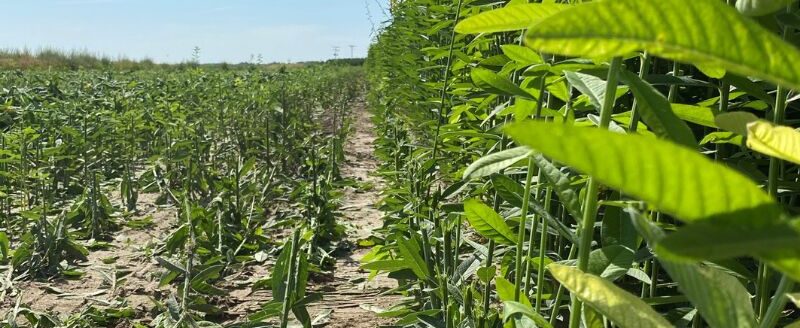MU research: Sunn hemp benefits rotational grazing systems
Sunn hemp’s vigorous growth makes it a great complement to cool-season forages, says Harley Naumann, University of Missouri forage physiologist.
Naumann’s six-year research shows that the quick-growing summer annual provides a boost during summer slump in rotational grazing systems.
“Most pastures in Missouri are comprised primarily of endophyte tall fescue that are not productive during the hot summer months,” says Valerie Tate, MU Extension field specialist in agronomy. “Sunn hemp is an excellent addition to a rotational grazing system.”
Originally grown as a fiber crop, sunn hemp draws its name from its bright yellow flowers.
The legume grows as much as an inch per day in an upright growth habit. It reaches heights of up to 9 feet.
This tropical flowering plant thrives in warm weather. Its seeds do not germinate until soil temperatures reach 70 degrees, and this short-day plant dies at the first frost.
Sunn hemp provides a lot of bang for the buck, with high nutritional value and additional carrying capacity in pounds of live animals per acre. It offers 20-25% crude protein and is 90% digestible. It increased cattle gain per acre by 17%, according to Naumann’s research.
Sunn hemp also produces and fixes significant amounts of nitrogen. According to USDA, it can produce more than 5,000 pounds of biomass and up to 100 pounds of nitrogen per acre. Grazing cattle recycle this nitrogen through their feces and urine. Unlike some other popular legumes, sunn hemp does not cause bloat in cattle. It tolerates dry conditions and low-fertility soils.
Sunn hemp also has another advantage that make it a wise choice in a well-managed forage system. “Sunn hemp can be drilled directly into tall fescue pastures without damaging existing stands,” says Tate, who serves on the NRCS+MU Grasslands Project.
Broadcast or drill seeds at a rate of 30 to 40 pounds per acre. Naumann says 30 pounds is “as good as 40 pounds.” Additional seeding causes detrimental crowding. He recommends inoculating seeds with cowpea-type rhizobia bacteria for good nitrogen fixation. It competes well when interseeded with fescue and suppresses weeds.
Sunn hemp’s strong regrowth ability is one of its best features. Grazing or clipping pushes hidden axillary buds to grow and branch out for more biomass. Graze plants when they reach heights of 1 1/2 to 3 feet.
Allow a 21-day rest period between grazing periods for best results, says Naumann. This depends upon the location and climate. Avoid letting plants overmature, he says. The stalks are less palatable than the leaves, which contain higher nutritive value. Cattle will graze down to a 12-inch stubble in rotational grazing systems.
Sunn hemp is a member of the genus Crotalaria. Its seeds are high in toxic pyrrolizidine alkaloids that can cause damage to some animals, especially pigs. Naumann recommends diluting the alkaloids by mixing other forages. “Dilution is the solution,” he says.
Tate says that sunn hemp not only provides additional forage, it dilutes toxic endophyte concentration in the diet of livestock. She also notes that sunn hemp adds diversity to wildlife systems. Wildlife, especially deer, enjoy its high-protein leaves.
For more information, see the USDA/NRCS guide to sunn hemp at plants.usda.gov/plantguide/pdf/pg_crju.pdf or visit the NRCS+MU Grasslands Project website at extension2.missouri.edu/programs/nrcs-mu-grasslands-project.


